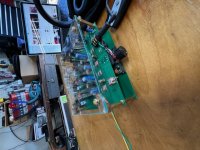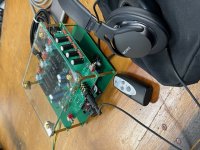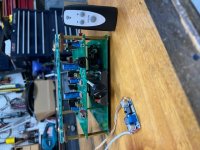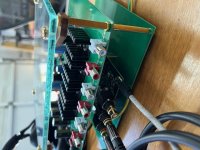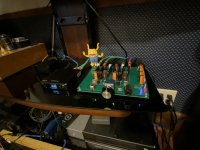still learning to use the scope, but if I'm doing it right it looks like one side has a voltage drop of 1.22v across that resistor, and the other side has 1.24v
1.22V vs 1.24V is only 0.14dB difference between channels based on that particular measurement, not significant AFAIK.
You better measure the gain of each channel with your scope, that will show you a better picture.
Or to simplify things, measure Vout with the same Vin for both channels. This will tell you the real difference between channels.
Once you know that number it is easy to trim feedback resistors to get to same Vout value.
Reading back the posts I realize I contradict a few other well esteemed participants.
Now, measuring V across R4 with a DMM is only measuring DC voltage, the gain of a feedback amplifier is much more complex than that.
Gain (Av) is Vout / Vin, it compares input waveform vs output waveform which is AC.
So the scope (or CRO as we say downunder) is the right tool for the job.
And will give you the best answer, but it needs to be interpreted the right way.
Isn't electronics fun?
Now, measuring V across R4 with a DMM is only measuring DC voltage, the gain of a feedback amplifier is much more complex than that.
Gain (Av) is Vout / Vin, it compares input waveform vs output waveform which is AC.
So the scope (or CRO as we say downunder) is the right tool for the job.
And will give you the best answer, but it needs to be interpreted the right way.
Isn't electronics fun?
That's exactly right, no AC voltage there (at R4).
Why concentrating on R4? It is not the part that decides the gain of this amp.
I thought audio amplifiers amplified AC signals, no?
And if that's the case Av (Vout / Vin) ultimately is determined by the feedback resistors in an amplifier with NFB - NFB is the key word here.
And if an amp has an imbalance between channels it would mean the gain in the two channels is not the same.
So not sure how considering DC conditions alone can solve the puzzle.
Happy to be proven wrong.
Why concentrating on R4? It is not the part that decides the gain of this amp.
I thought audio amplifiers amplified AC signals, no?
And if that's the case Av (Vout / Vin) ultimately is determined by the feedback resistors in an amplifier with NFB - NFB is the key word here.
And if an amp has an imbalance between channels it would mean the gain in the two channels is not the same.
So not sure how considering DC conditions alone can solve the puzzle.
Happy to be proven wrong.
Some help needed, please!
Guys, I had my ACP+ naked kit up and running for a couple of weeks, but I HAD to try Andynor' s idea of replacing the input capacitors with Silmic II.
Power off, removed power plug, rcas and headphone.
While I was at it, decided to reflow some solderings.
At a given point, there was a tiny spark and bingo! : left channel dead.
Voltage across R15 that used to be 4.6 V is now 12 V and at the point close to R12 and R13 is now 0 V instead of the previous 11 V.
Q6 os dead cold and Q2 gets hot after a few seconds of power on.
Any idea of what I might have fried?
Any help is appreciated
Guys, I had my ACP+ naked kit up and running for a couple of weeks, but I HAD to try Andynor' s idea of replacing the input capacitors with Silmic II.
Power off, removed power plug, rcas and headphone.
While I was at it, decided to reflow some solderings.
At a given point, there was a tiny spark and bingo! : left channel dead.
Voltage across R15 that used to be 4.6 V is now 12 V and at the point close to R12 and R13 is now 0 V instead of the previous 11 V.
Q6 os dead cold and Q2 gets hot after a few seconds of power on.
Any idea of what I might have fried?
Any help is appreciated
Last edited:
Q3, the J113, may be damaged. What is the resistor value of R4 and what is the voltage drop across it?
The capacitors should be discharged after power off. Was the spark after you had replaced the capacitor or before? And had you powered it up at all after the capacitor replacement but before the spark?
Edit: "The capacitors should be discharged after power off. " No need to manually discharge them - they should discharge themselves in circuit on their own if everything is functioning correctly.
The capacitors should be discharged after power off. Was the spark after you had replaced the capacitor or before? And had you powered it up at all after the capacitor replacement but before the spark?
Edit: "The capacitors should be discharged after power off. " No need to manually discharge them - they should discharge themselves in circuit on their own if everything is functioning correctly.
Last edited:
My multi-purpose ACP+
Thanks Guiness for posting PICs of your ACP+. It got me thinking that I needed a DAC so I purchased at Tone One from KHADAS.COM and I just installed it like you did on the ground plane under the ACP+ board. It's amazing what a difference getting lossless high bit rate music can make. I have been browsing on AppleMusic and trying to compare the quality of the music from that source to what I had been listening to (Pandora free service and my iTunes library).
Since I am using the ACP+ both as a headphone amp and a line stage/Preamp for my Sony P-channel Vfet I also decided to add the convenience of a remote mute and volume control. I took the simple way out and purchased a $40US motorized potentiometer from China (on eBAY). It consisted of a knock-off ALPS "Blue" 50k motor-driven potentiometer, (I believe it is a knock-off -- no "real" ALPS label on the pot) as well as a IR receiver and remote. It provides volume up and down and mute. It seems to work well -- I can't hear any difference in the music. But I did not just trust my ears, I also made some before and after measurements on the + 24 volt rail looking for AC ripple and found no difference (original non-motorized pot readings vs: the set up with the motorized pot board installed as well as an inexpensive ( 10 for $10 from Amazon) "buck boost" board that provides the 12 volts for the motorized pot board.
So I opted for a high quality DAC music source coupled with the convenience of remote volume/mute control. This set up works for me for every day listening in my living room.
I'm so pleased with this ACP+ driving my Sony P-channel Vfet that I'm in no real rush to start on the BA 2018 Line Stage that's waiting for me to get over my fear of working with surface mount transistors (8 of those pesky parts...)
I highly recommend this DAC ($79US). And for the convenience factor, the motorized potentiometer. Or you can opt for a $99US MUSES digital volume control with remote and display from Academy Audio -- and have to deal with rigging up plus and minus ~14 volts to power the unit... I'm not sure what I will do for the BA 2018 line stage -- most folks would opt for either step attenuators or that Muses board, I suspect...
One final note, I had the original 20k ALPS potentiometer from the ACP+ build and if the Chinese knock-off proved to be lacking, I was going to dismantle the motorized pot and swap out the "real" ALPS 20k pot for the 50k knock-off one...
turns out I did not have to do that extra work...
HappyJack
Adydula's posted reminded me to share a few images of my ACP+. Pretty standard build with the exception of the Khadas Tone DAC mounted below the amp.
This little setup has been running 40hrs a week as my new office setup. Very nice indeed!
Thanks Guiness for posting PICs of your ACP+. It got me thinking that I needed a DAC so I purchased at Tone One from KHADAS.COM and I just installed it like you did on the ground plane under the ACP+ board. It's amazing what a difference getting lossless high bit rate music can make. I have been browsing on AppleMusic and trying to compare the quality of the music from that source to what I had been listening to (Pandora free service and my iTunes library).
Since I am using the ACP+ both as a headphone amp and a line stage/Preamp for my Sony P-channel Vfet I also decided to add the convenience of a remote mute and volume control. I took the simple way out and purchased a $40US motorized potentiometer from China (on eBAY). It consisted of a knock-off ALPS "Blue" 50k motor-driven potentiometer, (I believe it is a knock-off -- no "real" ALPS label on the pot) as well as a IR receiver and remote. It provides volume up and down and mute. It seems to work well -- I can't hear any difference in the music. But I did not just trust my ears, I also made some before and after measurements on the + 24 volt rail looking for AC ripple and found no difference (original non-motorized pot readings vs: the set up with the motorized pot board installed as well as an inexpensive ( 10 for $10 from Amazon) "buck boost" board that provides the 12 volts for the motorized pot board.
So I opted for a high quality DAC music source coupled with the convenience of remote volume/mute control. This set up works for me for every day listening in my living room.
I'm so pleased with this ACP+ driving my Sony P-channel Vfet that I'm in no real rush to start on the BA 2018 Line Stage that's waiting for me to get over my fear of working with surface mount transistors (8 of those pesky parts...)
I highly recommend this DAC ($79US). And for the convenience factor, the motorized potentiometer. Or you can opt for a $99US MUSES digital volume control with remote and display from Academy Audio -- and have to deal with rigging up plus and minus ~14 volts to power the unit... I'm not sure what I will do for the BA 2018 line stage -- most folks would opt for either step attenuators or that Muses board, I suspect...
One final note, I had the original 20k ALPS potentiometer from the ACP+ build and if the Chinese knock-off proved to be lacking, I was going to dismantle the motorized pot and swap out the "real" ALPS 20k pot for the 50k knock-off one...
turns out I did not have to do that extra work...
HappyJack
Attachments
Billyk,
The Muses digital volume board would be a better way to go -- would you make an additional linear + and - ~14 volt power supply? Since the Muses board is directly in the signal path, trying to use the buck/boost method off of your existing linear ps could possibly negate all your gains made using that linear 24 volt source for you ACP+...??? and possibly induce audible noise???
It might be an interesting exercise to put a scope on the DC rails and see how much ripple and at what frequency the ripple is -- and experiment with a couple of the inexpensive buck/boost boards -- measuring if those boards are a source noise/ripple (I'd try it but my last o'scope was a Tektronics 545B which died some 20 years age...)
Let us know how it goes!!
HappyJack
The Muses digital volume board would be a better way to go -- would you make an additional linear + and - ~14 volt power supply? Since the Muses board is directly in the signal path, trying to use the buck/boost method off of your existing linear ps could possibly negate all your gains made using that linear 24 volt source for you ACP+...??? and possibly induce audible noise???
It might be an interesting exercise to put a scope on the DC rails and see how much ripple and at what frequency the ripple is -- and experiment with a couple of the inexpensive buck/boost boards -- measuring if those boards are a source noise/ripple (I'd try it but my last o'scope was a Tektronics 545B which died some 20 years age...)
Let us know how it goes!!
HappyJack
Hey!
The plan is to incorporate the muses. The linear ps is something I had, I’ll be using a Meanwell IRM 60 24 as the main ps, and Meanwell NSD 15 for the +/- 14 muses ps. Also be using some of the PO89ZB filters from the store. I love the naked board look so will make it remote with umbilical. Still working on mounting the muses in an attractive way.
The plan is to incorporate the muses. The linear ps is something I had, I’ll be using a Meanwell IRM 60 24 as the main ps, and Meanwell NSD 15 for the +/- 14 muses ps. Also be using some of the PO89ZB filters from the store. I love the naked board look so will make it remote with umbilical. Still working on mounting the muses in an attractive way.
Hi All,
Is there any contraindication in putting in the same cabinet a Raspberry Pi with DAC hat and the ACP in order to make a little night table system? Especially in winter I often have to spend may hours in bed, so I'd like to access to the NAS and enjoy music on headphones with a very compact system...

Is there any contraindication in putting in the same cabinet a Raspberry Pi with DAC hat and the ACP in order to make a little night table system? Especially in winter I often have to spend may hours in bed, so I'd like to access to the NAS and enjoy music on headphones with a very compact system...

Hi All,
Is there any contraindication in putting in the same cabinet a Raspberry Pi with DAC hat and the ACP in order to make a little night table system? Especially in winter I often have to spend may hours in bed, so I'd like to access to the NAS and enjoy music on headphones with a very compact system...

God damn ‘Talians!
Good idea. I would say there is plenty of indication to do that

It’s important to have a good time in bed

I was inspired by the cromatic multicolor components and thought to give a touch of pitoresque color.
In the last two weeks saw a plastic bricks chassis and that inspired as well.
For the technical part, all perfect although i am not a electronic wizard, more incline to be a donkey! I will post feedback on sound later, i just wanted to finish the cosmetics.but the unique 3 mins it Played it calls for clarity and extension. More to follow
Yea those orange EPCOS caps are quite the color.
--Tom
- Home
- Amplifiers
- Pass Labs
- Amp Camp Pre+Headphone Amp - ACP+
